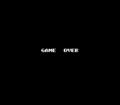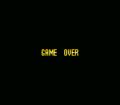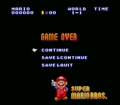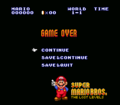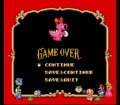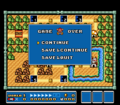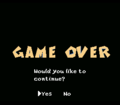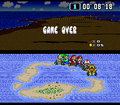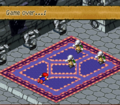Game Over
Game Over is a common term used in the Mario franchise and most other video games that is given to the player when they run out of lives/chances. Usually they cannot continue and must restart the game, but can still often load their progress. In few cases, they cannot load any progress at all and a Game Over can be more of a big deal than in other games; this usually applies to games lacking save features, a subtype that usually consists of games from older hardware generations.
The game over screen differs from game to game, but the text is usually against a black screen and playing background music with a sad tone that seems to mock the player.
There also exists non-standard game overs, which involve special punishments for specific mistakes.
"Game Over" as death
- “Peach... Noble princess, pure of heart... Do you take Bowser to be your lawfully wedded husband 'til your game be over?”
- —Count Bleck, Super Paper Mario
As referenced throughout Super Paper Mario, a Game Over for Mario series characters is their equivalent of death, as extra lives make mere "death" a mild hiccup.[1]
In that game, Dimentio sends Mario and his teammates to "the next world", albeit "while still very much alive",[2] which is like either going to Heaven or Hell. Mario, Luigi, and Bowser end up in The Underwhere which is a little like Hell, where some Shaydes ask Mario how his "game", referring to his life, was. Also, many Shaydes can be seen discussing how they got a Game Over. The Overthere, is like the Heaven surrounded in clouds, sun, and rainbows. It is where Princess Peach went.
That said, all the conversations in the The Underwhere seem to suggest that Shaydes can request an audience with Queen Jaydes who will weigh in their sins and send them to The Overthere, submit them to punishments befitting of their crimes or even return them to the land of the playing if the situation calls it.
It is never clearly shown the areas of The Underwhere or The Overthere where Jaydes sends the dead people; all that are seen in The Underwhere are Shaydes that have not yet requested an audience with Jaydes, and D-Men who work for her, while all that are seen in The Overthere are Nimbis (and Skellobits that are invading). It is implied that the dead villains are condemned to an area below The Underwhere, where Bonechill was also imprisoned before he escaped. It is possible that the paradise dimension witnessed at the end credits may be an area of The Overthere, though what Nastasia says seems to suggest otherwise.[3]
One Shayde speculates that if a dead person dies in the Underwhere or Overthere, their aftergame ends and they go to a "post-aftergame".
When Count Bleck was using The Void to destroy all worlds, The Void also appeared in the Overthere, indicating that it would even destroy the aftergame. Where all the dead characters (or even all the characters altogether) would have gone following the aftergame's destruction is unknown, however a young Flip-Flop girl speculates that the souls of the deceased would be forced to drift aimlessly in the empty white space left behind by The Void due to being left without a world or aftergame to reside in, a fate deemed both sad and boring.
Aside from Bowser (who appears to have infinite lives, as seen in Paper Mario: The Thousand-Year Door, though his death in New Super Mario Bros. seems to be the exception, as he has to be revived by Bowser Jr. from his bones), several enemies have appeared to return from the dead. The most infamous is Petey Piranha, who dies after each battle, yet often returns for another game. King Boo was apparently destroyed in Super Mario Sunshine, yet returned in Super Princess Peach. Also, the Koopalings were seemingly killed in their respective battles in Super Mario World (either falling into the lava or vanishing in a puff of smoke before their castle blows up), yet they returned in Mario & Luigi: Superstar Saga, New Super Mario Bros. Wii and New Super Mario Bros. U. It is likely that Bowser somehow revived all seven for their next appearances. This suggests that he has the power to resurrect his destroyed followers, as Bowser Jr. did for him in New Super Mario Bros.. This is also evident with Bowser's legion of undead (such as Dry Bones and Boos).
In Super Smash Bros. Brawl, if Solid Snake starts a Codec Conversation on Pit, he will say "And by trials, you mean, 'Game Overs'?"
Notable "Game Over" screens
Video games
In Super Mario Bros. and Super Mario Bros.: The Lost Levels, when the player runs out of lives, the level turns into a black background with the words "GAME OVER", while the HUD is still present.
In Super Mario Bros.: The Lost Levels, if the player runs out of lives in World 9, the Game Over screen looks different. Under the words that say Game Over, there is a message that reads: "YOU'RE A SUPER PLAYER! WE HOPE WE'LL SEE YOU AGAIN. MARIO AND STAFF."
In Super Mario Bros. 2, the Game Over screen just depicts the words "GAME OVER" in a black background. After the Game Over music has played, the text changes into two choices, reading "CONTINUE" and "QUIT". If the player chooses "CONTINUE", the game will resume, but if the player chooses "QUIT", the game will return to the title screen.
In Super Mario Bros. 3, receiving a Game Over will return the player to the map, while a blue square appears with the words "Game Over", with a "dead" Mario in between the words.
In Super Mario 64, when Mario gets a Game Over, the player will return to the title screen, except the background is red and reads "Game Over". A piece of "Bob-Omb Battlefield" music plays, slowly decreasing in pitch, and Mario's face looks worn out. The main menu music then plays and rises back to its normal pitch. In Super Mario 64 DS, Mario's face doesn't appear, but the music decreasing pitch still plays. Also, the background is a dark grey gradient instead of red and without text reading "Game Over".
In Super Mario Sunshine, Super Mario Galaxy, and Super Mario Galaxy 2, the "Too Bad!" sign changes into a Game Over sign if no more lives are left (in translated versions of Super Mario Sunshine, the "Too Bad!" sign says "Arrivederci", Italian for "goodbye". In the Japanese version, however, it says "Miss!" instead). In Super Mario Sunshine, the color is red, in Super Mario Galaxy, the color is purple, and in Super Mario Galaxy 2, the color is yellow.
In Super Mario 3D Land, there is a yellow background, and Mario or Luigi falls onto the ground, depressed, and a Game Over sign appears. If the player selects "Quit" on the Touch Screen, Mario or Luigi will become even more depressed and the game progress will be saved, but if the player selects "Continue", Mario or Luigi will happily run away. After this, he will go to the Hint Room, with a special power-up and a Toad explaining a basic use of the power-up to Mario, but only in the normal worlds. Super Mario 3D World also has the same game over screen and concept except it has a red background and when the player picks "Continue", all Toad Houses and Lucky Houses will be reopened.
In Paper Mario and Paper Mario: The Thousand-Year Door, the Game Over screen depicts Mario lying dead under a spotlight with the orange words GAME OVER while the classic Mario series Game Over theme plays. In addition, the latter is one of the first Mario games to feature non-standard Game Overs with 5 total (for example, getting crushed by the spiked ceiling in Hooktail's castle or reading Ghost T.'s diary in The Thousand-Year Door). In Super Paper Mario, the music and the words remain, but the fallen Mario is not present. It retains the non-standard ways to get Game Overs; for example, refusing to answer either Merlon's pleas for help at the beginning of the game (before the player even first takes control of Mario) or Squirps' request to wear a helmet in Outer Space will result in a Game Over. In Paper Mario: Sticker Star, it has a similar concept as Paper Mario and Paper Mario: The Thousand-Year Door, but the spotlight and text are purple and a different tune is present. There is a way to get a Game Over which is letting the Big Cheep Cheep explode on Mario without a Spike Helmet.
In Luigi's Mansion and Luigi's Mansion: Dark Moon, when a game over occurs, instead of the usual game over sign, the text will read "Good night!" as if Luigi has fainted and/or fell asleep. In the first game, when a game over occurs, the player will be taken back to the title screen, but in the sequel, the player is asked if they will restart to the beginning of the mission or return to the Bunker; however, in ScareScraper, when the player(s) fail(s) a floor, a game over occurs, but it will read "Game Over" instead of the usual "Good night!". If playing local or download play, the host (player) will be asked if they can play again. The Luigi's Mansion beta's Game Over shows two Game Over screens, played in order: the first is the same as the final, but with no music; the second Game Over screen shows Luigi standing in front of the mansion seemingly now a zombie while lightning strikes, without any text.
In Donkey Kong Country, the game over shows a screen of Donkey Kong and Diddy Kong in bandages in a black background with depressing music and a deranged text font. This carries over to its GBA port which changes it to a jungle background.
In Donkey Kong Country 2: Diddy's Kong Quest, the Game Over screen consists of Diddy Kong and Dixie Kong appearing tied to each other in a black cell, with Diddy having a scared face looking out the window and Dixie having a depressed face looking away. The screen then turns into a red tint. The background image can also be seen in error and antipiracy screens in the game. This also carries over to its GBA port.
In Donkey Kong Country 3: Dixie Kong's Double Trouble, the Game Over screen consists of a image of Dixie Kong and Kiddy Kong in a dark room with a crib. Dixie appears to have an angry face, and Kiddy has a sad face. The screen then goes black with a door shutting. As with Diddy's Kong Quest, the background image is also shown in antipiracy and error screens in the game. This once again carries over to its GBA port.
In Donkey Kong 64, if the player chooses Quit in the pause menu, a brief cinematic appears showing King K. Rool laughing maniacally and crazily while aiming the Blast-o-Matic at Donkey Kong Island; this cinematic also shows up if the Kongs fail to shut down the machine's generator.
In Mario & Luigi: Superstar Saga, if both Mario and Luigi reach zero HP in battle, a rounded-curved red "Game Over" text appears and the last Bro. to fall says "Mama Mia!". Since defeating Queen Bean, the player has an option to continue the game from the last saved point, or from Beanbean Castle; the latter choice does not revert play time to when the game is last saved.
In Mario & Luigi: Partners in Time there are two game over screens. One of them appears if Mario and Co. are felled in battle, which have eerie purple, smoky text which seem to allude to the Shroobs. The other one appears if they lose the battle against the Shroob UFOs (or later, the Shroob Mothership in Shroob Castle), which shows the party depressed while Shroob laughter is heard in the background, symbolizing their conquest succeeded.
In Mario & Luigi: Bowser's Inside Story, the Game Over text is colored yellow, and it uses a font slightly similar to that of the traditional one used in the Mario series.
In Mario vs. Donkey Kong, the Game Over screen depicts a depressed Mario and the outlined words "GAME OVER", as well as two choices, "Restart" and "Quit". If the player selects "Restart", the stage where the player lost will be restarted, but if the player selects "Quit", the game will return to the stage select screen. In Mario vs. Donkey Kong 2: March of the Minis, the sign has a wobbly red font, and there is a depressed Mini Mario in place of Mario. Versions of Mario vs. Donkey Kong 2: March of the Minis localized outside the United States have the font for the sign resembling the text's font shown on the "Retry" and "Quit" buttons in the same screen.
In the WarioWare games, if the player loses all 4 lives on a stage, a Game Over occurs, with a differing design and font, depending on the stage the player is playing. Usually after this happens, in the scores screen that follows, the background image depicts the stage's owner(s) being depressed.
Wario Land 3 has a very unique Game Over screen. Wario is ordinarily invincible in this game; the only possible way to get a Game Over at all is to lose to the final boss, which is the only enemy that can actually kill him. Even so, he can still get right back up and try again.
In Super Mario Kart, if the player is out of chances to retry, a white Game Over sign with a bubbly font will bounce into the screen. If 2 players lose all chances at the same time, there will be 2 Game Overs. If one player loses all chances while the other player continues, there will be a Game Over while racing. Also, if the player finishes a cup in 4th place or below, a Game Over occurs, but will read
"[X]cc [name of cup] CUP RACE
[character's name] CAME IN [X]TH PLACE.
TRY AGAIN."
instead of the Game Over sign. Starting from Mario Kart 64, with the exception of Mario Kart: Super Circuit, there are no chances, so Game Overs will only occur if the player finishes a cup in 4th place or below in Grand Prix mode, that don't have the usual "Game Over" text. There is also a way to get a Game Over by finishing a track in 5th place or below, but it doesn't display the "Game Over" text as well. In Super Mario Kart, the text which displays when finishing in 5th place or below reads "RANKED OUT" in the same bubbly font as the Game Over sign, although it is red.
The Mario Party series very rarely has any Game Overs, with the exception of the first game, Mario Party Advance and Mario Party: Island Tour. In the first game, getting a Game Over is only able to do if the player run out of lives on the Minigame Island, while in Advance a Game Over will occur if the player runs out of Mushrooms. In Island Tour, when the player fails a minigame in Bowser's Tower, the character will start doing their 4th place animation under a yellow-orange spotlight with the red words saying "GAME OVER". If the player clicks on "Continue", the player will continue from the point where they fail the minigame. If the player clicks on "Quit", the player will return to the select screen.
In Mario & Luigi: Dream Team, the Game Over text is completely blue. Fake Game Overs also appear in the game, which involves a fountain on the summit of Mount Pajamaja, or a certain part of Dreamy Mount Pajamaja. If Mario and Luigi drink from it for the first time, they will fall fast asleep and have a nightmare about getting giant after eating too many Mushrooms, and realize they cannot survive like this. Another nightmare involves Mario and Luigi powering up to corner Bowser and Antasma and save the Dream Stone, leaving Dreambert to free all the Pi'illos and welcome all tourists. After the screen goes black, a fake Game Over appears. A few moments after the "Game Over" screen fades in, Prince Dreambert yells "MARIO! LUIGI! WAKE UP! NOW!". This fake Game Over won't happen for the rest of the game after it is triggered for the first time. Game Overs also result from losing in Battle Broque Madame and Mad Skillathon (whether if the player loses all lives or all 30 seconds are used up)
Captain Toad: Treasure Tracker shares the same Game Over look with Super Mario 3D World. However, the Game Over screen is situated on a black polka-dot like background.
Other media
Game Overs also appear in the Nintendo Adventure Books, used after a bad ending(s) has(ve) occured. An example of getting a Game Over in these books is in Leaping Lizards, where an Anchor is a dud item; it will drag Luigi down if he falls into a body of water.
Game Overs appear in the Mario comics of the Nintendo Comics System, ending the story. They appear in the final page on one corner of it.
A Game Over happens twice in the movie Super Mario Bros.: Peach-hime Kyushutsu Dai Sakusen!, the first time when Bowser and Peach vanish on Mario's TV screen, and the second time while Bowser and his minions are working at Mario and Luigi's shop at the end of the movie.
Gallery
Nintendo Entertainment System
- SMB - Game Over Screenshot.png
Super Mario Bros.
- Special Game Over.PNG
World 9 of Super Mario Bros.: The Lost Levels
- Super Mario Bros 3 Game Over.jpeg
Super Mario Bros 3
Super Nintendo Entertainment System
- Fixed 00000.png
Super Mario Kart (multiplayer mode)
- DKC gameover.png
Donkey Kong Country
- DKC gameover Diddy & Dixie.png
Donkey Kong Country 2: Diddy's Kong Quest
- Poorkongs.png
Donkey Kong Country 3: Dixie Kong's Double Trouble!
Nintendo 64
- Mario Kart 64 (U) snap0014.jpg
Mario Kart 64
- Yoshi's Story (U) (M2) snap0078.jpg
Yoshi's Story
- DK64 Game Over.PNG
Donkey Kong 64
Nintendo GameCube
- Luigis14.jpg
Luigi's Mansion (beta version)
Wii
- SPM Game Over.jpg
Super Paper Mario
- Game Over SSBB.jpg
Super Smash Bros. Brawl
Wii U
- NSMBU Game Over.jpeg
New Super Mario Bros U
- SM3DW GameOver.png
Super Mario 3D World
Game & Wario (Gamer stage)
Game Boy & Game Boy Color
- DKL GO.png
Donkey Kong Land
- DKL3 GO.jpeg
Donkey Kong Land III
- DKL3 GO GBC.jpg
Donkey Kong Land III (Game Boy Color)
Game Boy Advance
- SMA1 Game Over.png
Super Mario Advance
- Mario Kart Super Circut Game Over.jpeg
Mario Kart Super Circuit
- Game Over.PNG
Super Mario Advance 3: Yoshi's Island
Nintendo DS
- WarioWare - Touched (Wario's stage).png
WarioWare: Touched! (Wario's stage)
- WarioWare - Touched (Album).png
WarioWare: Touched! (Album)
Nintendo 3DS
- SM3DLand Game Over.jpeg
Super Mario 3D Land
- PMSS Game Over.jpg
Paper Mario: Sticker Star
- New Super Mario Bros 2 Game Over.jpg
New Super Mario Bros 2
- MLDT Game over.jpg
Mario & Luigi: Dream Team
Other media
To be added; see the "Game Overs from other media" section in the talk page.
References
- ^ A Shayde: "Huh? What'd you say? "What's The Underwhere?" ...You're kidding, right? Man, for a guy with no extra lives, you're sure hilarious! Isn't it obvious? This is where people go when their games are OVER! Some call it "World -1"..."
- ^ Queen Jaydes: And by the way, it may please you to know that your game is not truly over. Somehow, you were sent to The Underwhere while still very much alive... My power can return you to your world if you so wish...
- ^ Princess Peach: Both Tippi and Count Bleck...gone. What could have happened to them?
Merlon: I shudder to think about it, but surely when the prophecy was nullified...
Nastasia: Um, no... They're alive. Yeah, they're finally united. They overcame time and fulfilled their old vows... Somewhere, the count...is living together with Tippi... in...um...happiness...
